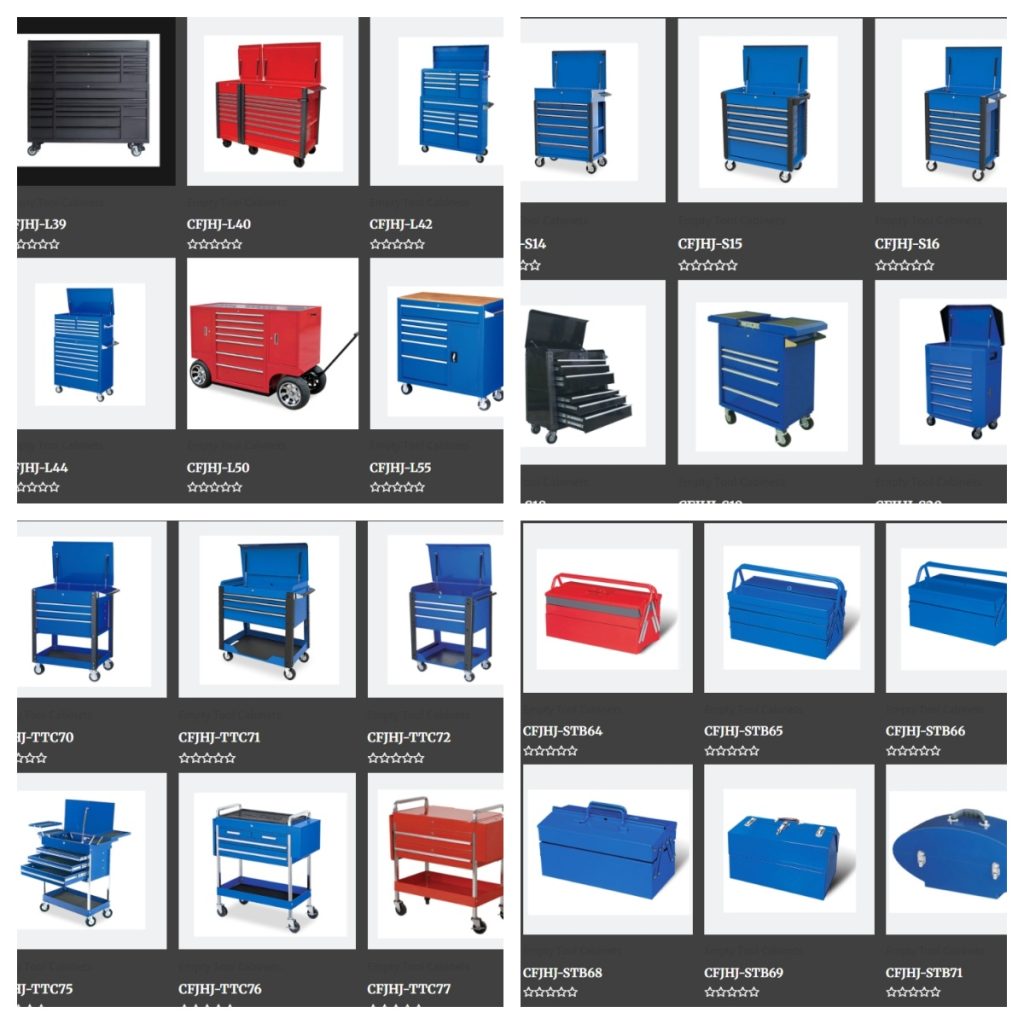- Ingenious ideas of structural design
(I) Cabinet frame: a solid foundation
The cabinet frame is the basic structure of the tool cabinet. Just like the foundation of a house, its stability directly determines the service life and safety of the tool cabinet. Among many materials, steel stands out with its high strength and good stability, becoming the preferred material for the cabinet frame. Steel has excellent compression, tension and torsion resistance, and can withstand the weight of the tools and possible external impact. Even when heavy tools are stored for a long time or subjected to certain collisions, the cabinet frame made of steel can maintain structural integrity and is not easy to deform.
In addition to the choice of materials, the connection method of the frame is also crucial. Common connection methods are welding and bolting. Welding is to melt the metal at high temperature to firmly combine the individual rods together to form a whole. The advantages of this connection method are high structural strength, good integrity, and the ability to withstand large external forces, but the disadvantage is that once the welding is completed, it is difficult to disassemble and adjust. If there is a problem, maintenance is relatively difficult. Bolt connection is to connect the rods by bolts and nuts. The advantage of this method is that it is easy to install and disassemble, which is convenient for later maintenance and adjustment. In addition, when the tool cabinet needs to be moved, it can be disassembled into parts for easy transportation. However, the bolt connection needs to ensure the tightness of the bolts, otherwise, during long-term use, the bolts may loosen due to vibration and other reasons, affecting the stability of the cabinet.

In some large industrial tool cabinets, in order to further enhance the stability of the cabinet frame, thickened steel is also used to make columns and beams, and reinforcing ribs are added at key locations. These reinforcing ribs are like the skeleton of the human body, which can effectively disperse and withstand pressure, improve the load-bearing capacity and anti-deformation ability of the cabinet, and ensure that the tool cabinet can remain stable even when fully loaded with tools.
(II) Drawers and shelves: the key to classified storage
Drawers and shelves are the key components of the tool cabinet to realize the classified storage function. Reasonable design can make the storage of tools more orderly and more convenient to use.
The design of drawers is very important. The first is the selection of drawer rails. The quality of the rails directly affects the user experience of the drawers. Common guide rails include roller type, steel ball type and hidden type. The roller type guide rail has a simple structure and low price, but its load-bearing capacity and smoothness are relatively poor, and it is easy to generate noise during the push and pull process. It is suitable for drawers that store lighter items and are not used frequently; the steel ball type guide rail realizes the opening and closing of the drawer through the rolling of steel balls. It has the advantages of smooth sliding, strong load-bearing capacity, and low noise. It is currently a widely used type of guide rail, which is very suitable for tool cabinets that need to be used frequently and may store heavier tools; the hidden type guide rail is completely hidden inside the drawer after installation, and has a beautiful appearance, but the installation is relatively complicated and the price is also high. It is usually used in occasions with high requirements for appearance. For tool cabinets, considering its usage scenarios and the characteristics of the items stored, the steel ball type guide rail is a more ideal choice, especially the fully extended steel ball type guide rail, which can allow the drawer to fully extend and facilitate the access to tools stored deep in the drawer.
The internal partition design of the drawer should not be ignored. Different types of tools have different shapes and sizes. If there is no reasonable partition, the drawer will appear messy, which will not only make it difficult to find tools, but also easily cause collisions between tools and cause damage. Therefore, it is very necessary to set up dividers inside the drawer. These dividers can be flexibly adjusted according to the type and size of the tools, dividing the drawer space into different areas. For example, special areas can be set up to store screwdrivers, wrenches, pliers, etc., so that each tool has its own “exclusive location”. Some advanced tool cabinet drawers are also equipped with adjustable dividers, and users can freely combine the partition areas according to actual needs to further improve the flexibility and efficiency of storage.
The shelves are mainly used to store larger tools or tool boxes, etc. In order to meet the storage needs of tools of different sizes, the height of the shelves is usually designed to be adjustable. Inside the cabinet, there will be a card slot or an adjustable support. By changing the position of the shelf in the card slot or adjusting the height of the support, the height of the shelf can be easily changed. For example, for some longer tools, such as saws, electric drills, etc., the shelf can be raised to leave enough space; while for some shorter tool boxes or small tools, the shelf can be lowered to make full use of the space. The design of adjustable shelves enables the tool cabinet to better adapt to the storage needs of different users and different tools, improving space utilization and convenience of use.
(III) Cabinet door design: a combination of protection and convenience
As an important part of the tool cabinet, the cabinet door not only protects the tools, but also is related to the convenience of use.
The material of the cabinet door is usually the same as the cabinet shell, and the common ones are cold-rolled steel plate, aluminum alloy, etc. Cold-rolled steel plate has the advantages of high strength, low cost, and good processing performance. After surface treatment, it can effectively prevent rust and corrosion, and provide reliable protection for tools. Aluminum alloy material has the characteristics of light weight, corrosion resistance, and beautiful appearance, which is suitable for occasions with high requirements on weight and appearance. Some high-end tool cabinets also use stainless steel cabinet doors, which have better anti-rust and anti-corrosion performance and can be used for a long time in harsh environments, but the cost is relatively high.
Sealing is one of the factors that need to be considered in cabinet door design. Good sealing can prevent dust, moisture, debris, etc. from entering the cabinet, avoiding contamination and damage to the tools. Especially for some precision tools or metal tools that are prone to rust, sealed cabinet doors can provide a relatively clean and dry storage environment to extend the service life of the tools. In order to improve the sealing performance, sealing strips are usually installed between the cabinet door and the cabinet body. These sealing strips are made of elastic materials such as rubber and have good sealing performance and aging resistance. When the cabinet door is closed, the sealing strip will be squeezed to fill the gap between the cabinet door and the cabinet body, thereby achieving a good sealing effect.
The design of the observation window provides great convenience for users. Through the transparent observation window, users can quickly check the storage of tools in the cabinet without opening the cabinet door, understand whether the tools are complete, and the approximate location of the tools, saving time in finding tools. The observation window is generally made of high-strength transparent materials, such as tempered glass, acrylic board, etc. These materials not only have good transparency, but also have certain strength and wear resistance. They can ensure the safety and durability of the cabinet door while ensuring the observation function.
Locks are important devices to ensure the safety of tools, especially for tool cabinets that store valuable tools or involve security-sensitive tools. The role of locks is more critical. Common locks include mechanical locks and electronic locks. Mechanical locks have simple structures, are easy to use, and have low costs, but their security is relatively limited; electronic locks have higher security and intelligence, such as password locks and fingerprint locks. The cabinet door can only be opened after entering the correct password or verifying the fingerprint, effectively preventing unauthorized personnel from taking tools at will and protecting the safety of the tools. Some advanced electronic locks also have functions such as recording unlocking time and alarm, which further improves the security and management convenience of tool cabinets.
(IV) Mobile parts: assistants for flexible operations
For some tool trolleys that need to be frequently moved between different work areas, the design of mobile parts is particularly important. Universal wheels, as common mobile parts, give tool cabinets the ability to move flexibly.
Universal wheels are usually installed at the bottom of the tool trolley and are generally composed of wheels, brackets and steering devices. The wheels are made of wear-resistant rubber or high-strength plastic, have good wear resistance and shock absorption performance, and can roll smoothly on different floors. The steering device allows the wheels to rotate 360 degrees, allowing the tool cabinet to easily achieve various moving operations such as forward, backward, and turning, and can also flexibly shuttle in a small space. For example, in a factory workshop, workers can easily push the tool trolley to the required working position without the effort of carrying tools, which improves work efficiency.
The brake device is an indispensable part of the universal wheel. When the tool trolley is moved to the designated position, the brake device can fix the wheels to prevent the tool cabinet from sliding at will, ensuring safety and stability during use. There are many ways to operate the brake device, the most common ones are foot-operated and hand-operated. The foot-operated brake realizes the braking function by stepping on the pedal, which is convenient and quick to operate and suitable for occasions that require frequent braking and movement; the hand-operated brake controls the brake by pulling the handle, and the braking force is large, which is suitable for occasions that require high braking stability. Regardless of the type of brake device, it needs to have reliable braking performance to ensure that the tool cabinet does not move when it is stationary.
To be continued……


